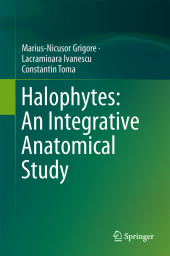 Neuerscheinungen 2014Stand: 2020-02-01 |
Schnellsuche
ISBN/Stichwort/Autor
|
Herderstraße 10
10625 Berlin
Tel.: 030 315 714 16
Fax 030 315 714 14
info@buchspektrum.de |

Marius-Nicusor Grigore, Lacramioara Ivanescu, Constantin Toma
(Beteiligte)
Halophytes: An Integrative Anatomical Study
2014. 2014. xiv, 548 S. 160 SW-Abb., 543 Farbabb. 235 mm
Verlag/Jahr: SPRINGER, BERLIN; SPRINGER INTERNATIONAL PUBLISHING 2014
ISBN: 3-319-05728-6 (3319057286)
Neue ISBN: 978-3-319-05728-6 (9783319057286)
Preis und Lieferzeit: Bitte klicken
This book focuses on morphological and anatomical strategies developed by halophytes during evolution that allow them to survive in high-salt environments. These adaptive strategies refer to well integrated structural features, such as succulence, salt secretion (salt glands and vesicular hairs), aerenchyma, Kranz anatomy, bulliform cells, successive cambia, tracheoidioblasts and endodermis with pronounced Casparian strips. The authors present cross sections of the roots, stems and leaves of 62 halophyte species belonging to 18 families from different habitats and climates (temperate, Mediterranean). They also discuss the ecological, physiological and evolutionary aspects of the various adaptive structures in an integrative way. Beginning with the structural level, this book offers novel insights into the ecology of halophytes and opens new perspectives for the identification of salt-tolerant crop plants or halophytes that can be used for ecological purposes, such as bio-remediation and revegetation.
Introduction
PART I: General Considerations on Halophytes
Halophytes definition and classification
Halophytes and their habitats. Finding a place within plant ecological classes
General morphological and anatomical adaptations in halophytes
Halophytes and salt stress. Histo-anatomical features in halophytes: formative effect, adaptation or a simple response to an intensely abiotic factor?
PART II: An Integrative Anatomical Study of Halophytes: Anatomical Structure in Different Family Species
Material and Methods
Caryophyllaceae
Chenopodiaceae (Amaranthaceae)
Polygonaceae
Plumbaginaceae
Fabaceae
Lythraceae
Apiaceae
Frankeniaceae
Brassicaceae
Primulaceae
Plantaginaceae
Asteraceae
Juncaginaceae
Cymodoceaceae
Iridaceae
Juncaceae
Cyperaceae
Poaceae
Part III: Conclusions
An Overall View on Halophytes Adaptations and Their Ecological Significance.
"This book, unique in its own way, focuses on the study of halophytes, plants able to survive in highly saline and arid conditions. Characterized by a great diversity and widespread in the plant world, they have a great theoretical and practical significance. ... In this way it represents a work of reference, a valuable scientific information instrument in the field of theoretical and practical biology, generally." (Aurelia Brezeanu, Romanian Journal of Biology, Vol. 58 (2), 2013)


